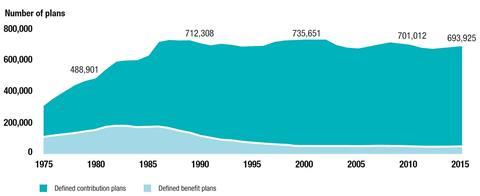The overall trend in US private sector pension provision is one of risk transfer from corporate plan sponsors to the beneficiaries, with companies seeking to avoid the long-term pension liabilities inherent in the DB plan structure. Corporate DB plans are closing to new members and converting pension provision to defined contribution arrangements. DB plans are entering into de-risking arrangements when their funding position allows. DC plans are now the dominant form of private sector retirement plans in the US. Given the decentralized investment decision-making by individual beneficiaries within these plans and the broad menu of choices they face, plan sponsors can be challenged to align their incentives with beneficiary preferences.
Even though investment risk has been shifted to the beneficiaries, those same beneficiaries can be hamstrung in their ability to make sound investment decisions given the need for the corporate plan sponsors to limit the options in their plans to manage costs, complexity and legal liability.
This classic economic agency problem creates a misalignment of plan sponsor and beneficiary incentives despite the widespread assumption that DC plans maximize and empower the individual worker. The proliferation of QDIAs has only increased this challenge.
ESG incorporation: expanding from a low base
The growth of ESG incorporation in US private sector pension plans reflects decisions made by various stakeholders at distinct levels. For DC plans, a plan sponsor may provide ESG options on its fund menu, but that offering may not translate into clear increases in ESG assets given that beneficiaries must actively seek out and select these options. Although there is no nationally representative data on how many retirement plans incorporate ESG factors, two large annual surveys report that only between 2 and 8% of DC plans offer their beneficiaries at least one ESG investment option, while only 3% of plan beneficiaries have selected an ESG option.

For DB plans, the reporting is somewhat clearer, as DB plans manage pension assets in aggregate pools. The Callan Institute’s 2017 ESG survey reported that 25% of corporate DB plans and 18% of corporate DC plans incorporated ESG factors. This compares with 35% of public sector plans. While the path to driving ESG incorporation for DB plans is clearer and depends primarily on the actions of institutional players, the future growth of ESG incorporation will largely depend on the individual choices of DC plan beneficiaries. This will require a shift to more grassroots-focused strategies.
ESG approaches and strategies not unique to private plans
The ESG investment strategies utilized in private retirement investing portfolios reflect the same approaches as the broad ESG industry. Based on the recent GAO Report [Table below], plans primarily use ESG integration, screening, and engagement. The literature on ESG investing and retirement savings focuses on the suitability of ESG investments for public pension funds and the permissibility of including ESG investments in private-sector plans. A few companies, including general investment firms (such as Vanguard and TIAA) and more specialized investment platforms (including Calvert and Social(k)), offer ESG investments for private-sector plans. Rather than use specific investment strategies for private retirement plans, these companies use standard ESG investment strategies, such as positive or negative screening methods, to select retirement plan investments.
| Strategy | Definition | Example |
|---|---|---|
|
Integration |
Information on ESG factors is considered along with other financial data as a core part of the investment analysis. |
Investment manager considers information on employee health and safety, greenhouse gas emissions, and water and wastewater management, among other information when assessing the valuation, risk, and potential growth for companies in industries where this is material (e.g., oil and gas exploration and production, mining). |
|
Screening |
Positive or negative screening to select investments based on established criteria. This strategy may be designed to maintain diversification across industries. |
Positive screening: Select companies with higher or improving ESG ratings relative to their peers. Negative screening: Exclude companies with low ESG ratings relative to their peers, while not excluding a whole industry. Exclude certain industries or products, such as tobacco or controversial weapons. |
|
Engagement |
Information on ESG factors is used for activities to monitor or influence the management of companies in which a plan owns stock, such as meeting with corporate boards and filing or voting on shareholder resolutions. |
Investment manager meets with board of directors or other representatives to assess how a company is managing material ESG factors. Examples may include the following, among others: • board composition and executive compensation; • policies and practices to address environmental or social factors that have an impact on shareholder value; and • long-term business plans, including plans on climate change preparedness and sustainability. |
Untangling stakeholders for broader impact: ERISA plans and ESG incorporation
- 1
- 2
- 3
 Currently reading
Currently readingTrends in the US pension market
- 4
- 5
- 6















